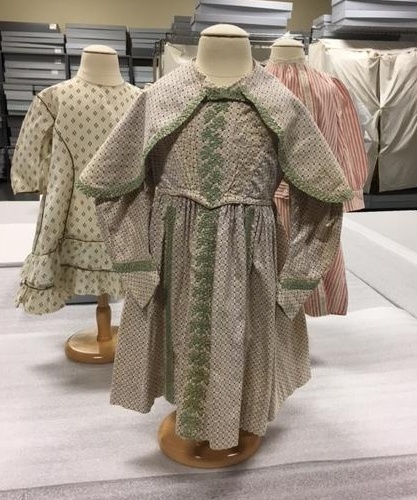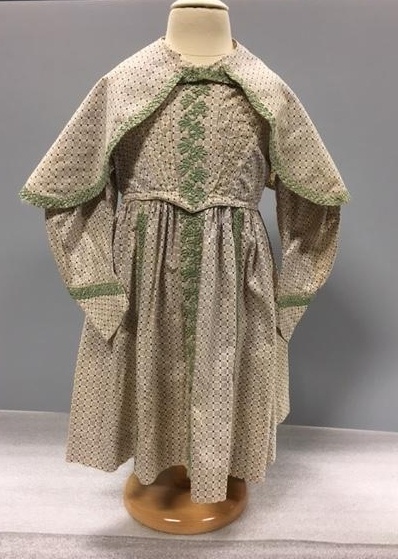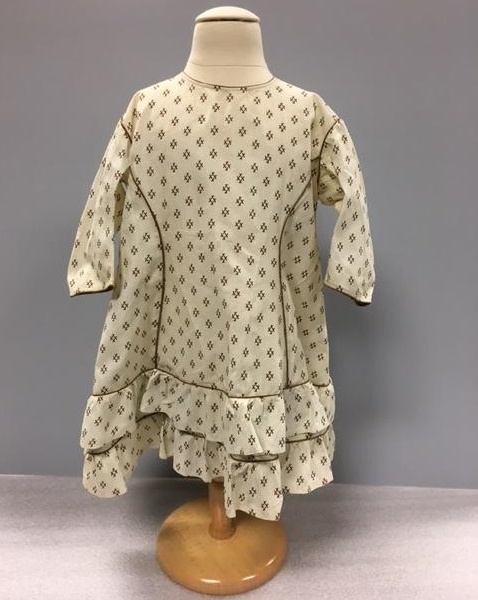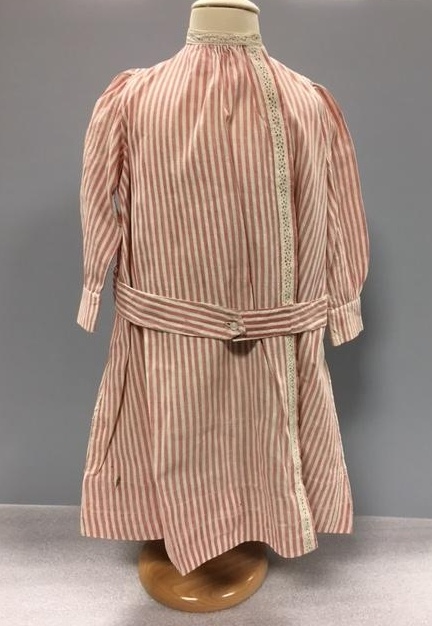Little Boys in Pink Dresses
Pink for a baby girl, blue for a boy, right? Not so, at least not until the twentieth century. In fact age, not gender, dictated the type of clothing a child would wear. Before age five to seven, boys and girls were dressed similarly, and their clothing was styled after women's dresses.
 Three boys' dresses from the Fashion Archives at the Maryland Historical Society
|
In the 18th and 19th centuries, infants' and toddlers' clothing dictated more their age than their gender. Infants wore long, white dresses similar to today's christening dress style until they could walk. Once the child started to walk, the long dresses were swapped for shorter styles that mimicked contemporary women's fashions.
 Boy's dress and matching capelet, c.1856,
1971.31.16a,b Gift of Mrs. Laurence Fowler
|
The dress above was worn by a three year old boy in 1856. The bodice, skirt, and sleeve styles are very similar to women's styles from that time. Some adjustments were made to accomodate the smaller stature of children; for example larger patterns and trims were scaled down as with the checkered pattern and green trim seen above. Additionally, the waist of the bodice is higher and less pointed than a woman's would be, and the back of the dress is closed with drawstrings which allow for growth of the toddler.
The additional work required to make such trims could become expensive, especially for children who are constantly growing or ruining their clothing. For this reason, Godey's Lady Book and other publications recommended simpler styles for young children.
 Boy's dress, c.1868, 1961.30.62
Gift of Miss Stella McNeal and Mrs. Marie Tittoni
|
The above style was common for little boys in the late 1860s. The piping on bodice creates a silhouette that mimics women's style, but the dress itself is larger to accommodate the un-corseted body of the boy and allow room to move.
So why were little boys wearing dresses until the early twentieth century? One reason may have been practicality. It is much easier to change a diaper with a dress than pants and during potty-training it would be easier for the child who didn't have to fumble with button closures on breeches. Another reason for imitating women's style was that it illustrated the dependence of the child on his mother. When the boy was “breeched” or given his first pair of pants, it was symbolic of the father taking over the education of the child. Finally, small boys and girls were dressed alike because they were seen alike. Infants and toddlers were all seen as innocent, meaning sexless or without gender. Dressing boys like little men would have been considered risqué as it insinuated manliness that was reserved for adult men.
There were, however, ways to subtly indicate your toddler was a boy, such as through color.
 Dress for a 3 year old boy, c.1900, 1951.44.11
Gift of Mrs. James Hooper Dorsey
|
This dress has several visual indicators that it was worn by a little boy. First, it's pink. That's right, pink was a boy color until later in the twentieth century! Pink was seen as a light red, and red was a very masculine color. Another indicator is the style of the closure- it is similar to a double breasted coat where the panels overlap and are secured with a button closure. Finally, the white vertical trim on this dress leaves little room for growth because while girls could wear dresses for many years, boys would be breeched after a few years.
It is not until the twentieth century with the creation of the ready-to-wear romper that little boys stopped wearing dresses. Of course, little girls were also dressed in rompers, so boys and girls still looked the same. It was at this point, when some feared putting girls in pants might ruin their femininity, that genders began to be more defined at a younger age.
The three boys' dresses in this blog post will be a part of our new exhibition, Structure + Perspective: David Brewster explores Maryland's Social Landscape, opening October 12th! Follow the link below find out more!
View Structure + Perspective
References:
Paoletti, Jo Barraclough, 2012. Pink and Blue: Telling the Boys from the Girls in America (Bloomington, IN: Indiana University Press)

